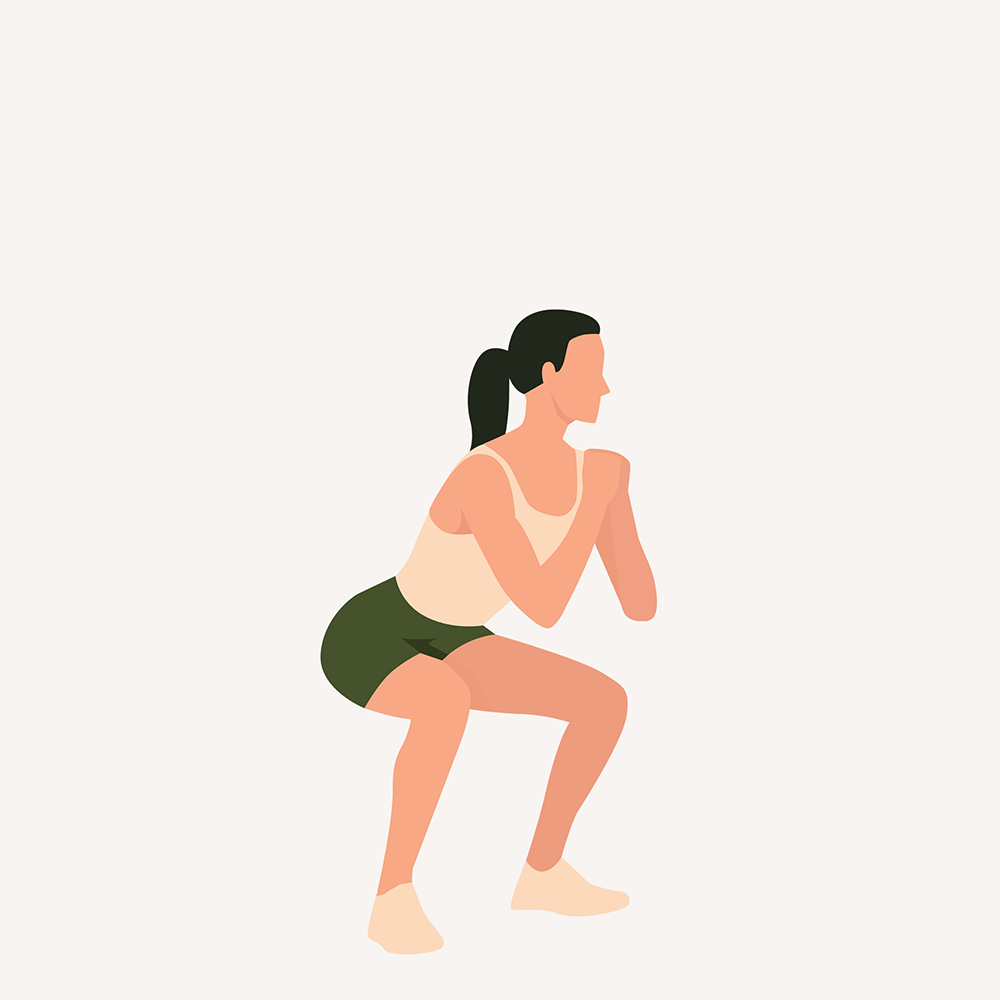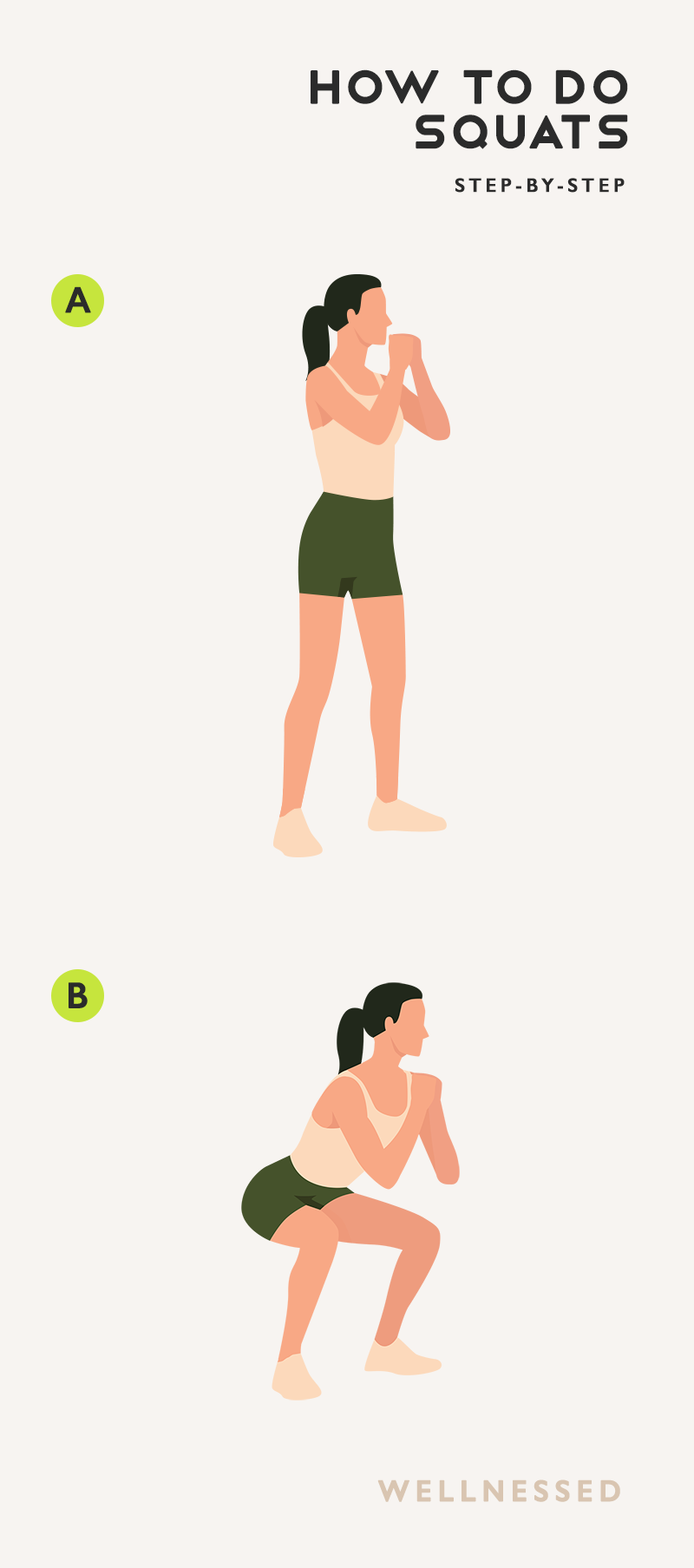- Main muscles worked: Front of thighs (quadriceps), butt (gluteus)
- Other muscles: Back of thighs (hamstrings), inner thigh (adductors), calves (soleus, gastrocnemius), core
- Exercise type: Compound, Push
- Equipment: None
Squats are a great exercise that can be performed almost anywhere. There are dozens of different squat variations to satisfy almost every goal and fitness level. However, most types of squats are performed similarly, using many of the same key principles. Therefore, first master the basic squat, also known as an air squat.
Benefits of Squats
Squats, sometimes hailed as the king of exercises, might just be the most functional exercise you can do. Sitting down to read this, you did a squat. You’ll do another when you get back up, take the stairs, or get in and out of your car. It’s almost impossible to get through the day without doing a whole bunch of squats. They’re crucial to living and aging well.12
Squats increase lower body strength and power, boost athletic performance, and develop injury resilience.34 Leg strength is vital for just about every type of sporting activity including running, jumping, and kicking. As a result squats are a popular exercise in strength workouts, often incorporated rehabilitation programs, and used as a test of lower-body strength.5
In addition, squats work the core muscles, which include the rectus abdominis (aka the abs), internal and external obliques, and erector spinae.6 High reps means it can be a real cardio blaster too. So here’s how to do a squat.
Squats can be performed at different depths. Fitness coaches often divide squats into roughly three categories:
- Partial squats – about 40° angle at the knee joint.
- Half or parallel squat – 70 to 90° knee angle.
- Deep or full squats – a knee angle greater than 90°.
How deep you squat will depend on your goals, flexibility, mobility, past injuries, body proportions and body type, and how your body moves through the movement.78
Deeper squats require greater mobility in the hips, knees, ankles, and spine, and are more challenging to execute with perfect form. Shallower squats are good for improving athletic performance, while deeper squats are good for for increasing muscle mass.9
However, if you have problems with mobility, pain, or other issues that prevent you from completing a squat with proper form, speak to your doctor or personal trainer first. For example, people with painful knees may compensate by bending over at the waist. This poor technique can lead to back pain.1011 They might advise you to do mobility exercises, perform a different squat variation, or recommend a lower-body exercise better suited to your needs.
Tips
Squat Form: The Detail
Executing squats with poor form will make the exercise less effective, and can lead to injury.12 Improperly executed, squats can put a lot more pressure on the joints, causing discomfort and pain. Follow these tips to ensure you get the most benefit possible.
- Shoes. Wear solid shoes that provide stability, such as weightlifting shoes. While running shoes are great for running, the spongy soles are not helpful when you squat because they compress when you push off the ground and destabilize you.
- Hips. Initiate the squat by pushing your hips back and then, just after, bending at the knees. This will help preserve your lower back arch and maximize the use of your hamstring and glute muscles. Breaking at the knee first is both inefficient and dangerous.
- Chest. Keep your chest up, which will prevent your shoulders and upper back from rounding. Look directly forward at all times. Look down and you’ll round your lower back; look up and you’ll lose hip-drive power. Keep your neck and spine neutral.
- Knees. Knees should stay in line with your toes as you descend, not caving inward or flaring outward, which stresses this joint unnecessarily. If you find your knees collapsing inward as you squat down, think about pushing your knees out so they stay aligned with your feet.
- Feet. Screw your feet into the ground. Your weight should be on your feet (not just your toes), which should remain flat on the ground. If your heels lift when you squat, this may be due to incorrect squat stance or restricted mobility caused by tight calves. If you have tight calves, do not ignore it. Place plates under your heels for support, but also work on increasing flexibility and stretching your calves more.
- Abs. To prevent your lower back from rounding, engage your core. A common cue to help with this to brace your abdomen like someone is going to punch you in the belly.
- Stance. Vary your foot angle and the width of your feet slightly, until you find the perfect position that allows you to perform the squat comfortably and with good form. A wider stance can be better for people with long legs relative to their torso (often long-limbed ectomorphs).13
Squats are a foundational exercise. They’re the cornerstone of many strength workouts, and are often used in rehab. Whether you want to go on to perform pistol squats, squat jumps, or weighted squats, master the basic squat first to get the most from this exercise.



